Fennel is a flowering plant in the carrot family that has become increasingly popular for its culinary and medicinal uses. It has a sweet, anise-like flavor similar to licorice and can be used in cooked and raw preparations. Fennel is high in dietary fiber and vitamins A and C, making it an excellent addition to any diet.
Additionally, its essential oils have been shown to possess anti-inflammatory, antioxidant, and antimicrobial properties – all of which may help support good health. This article will explore fennel’s nutrition profile, health benefits, potential risks, and more.
What is Fennel?
Fennel, scientifically known as Foeniculum vulgare, is an herbaceous plant native to the Mediterranean regions of Europe and Asia. The flowering plant grows up to four feet tall and produces yellow flowers. Its seed-like fruits commonly referred to as fennel seeds, have a sweet licorice taste with hints of anise or lemon.
History and Origin of Fennel:
Fennel is thought to have originated in the Mediterranean region, where the ancient Greeks first described it. They believed that fennel bestowed strength and courage upon those who consumed it. The Romans, too, valued fennel’s healing properties and used it to treat various ailments.
Throughout history, people in many cultures have used fennel as a culinary herb and traditional remedy for various conditions. Today, it remains popular in cooking, especially in Italian cuisine.

Types of Fennel:
Fennel is divided into two main categories: sweet fennel and bitter fennel. Sweet fennel, or Florence fennel or finocchio, is the edible variety most commonly found in grocery stores. Bitter fennel produces fruits with a stronger flavor and aroma that are unsuitable for eating.
Nutrition Profile of Fennel:
Fennel is low in calories yet high in nutrients. It contains significant dietary fiber, manganese, magnesium, iron, potassium, and phosphorus. Additionally, it is a good source of vitamin C and B vitamins like folate. It also contains small amounts of calcium and omega-3 fatty acids.
Health Benefits of Fennel:
Fennel has been associated with several health benefits primarily due to its nutrient content. These include:
- Improved digestion: Fennel is high in dietary fiber, which helps support healthy digestion by promoting regularity and eliminating toxins from the digestive tract. It also contains compounds that may help reduce inflammation in the gut, improving symptoms of irritable bowel syndrome (IBS) or other digestive disorders.
- Lower blood sugar: Fennel has been shown to positively affect blood sugar levels, which may be beneficial for people with diabetes or prediabetes.
- Heart health: The potassium and magnesium found in fennel can help support heart health by regulating blood pressure and reducing the risk of stroke, heart attack, and other cardiovascular diseases.
- Bone health: Fennel is high in calcium which can help strengthen bones and reduce the risk of osteoporosis.
- Antioxidants: The antioxidants found in fennel may help protect cells from damage caused by environmental toxins and free radicals that can lead to chronic disease.
How to Plant Fennel?
Fennel is a popular and versatile garden herb used in many dishes. Its delicate flavor adds an interesting dimension to salads, roasted vegetables, and soups. Fennel has a long history of being cultivated as a culinary and medicinal plant, but it can also be grown for its beauty. Whether you’re growing it for cooking or ornamental purposes, learning how to plant fennel correctly will ensure that your plants are healthy and productive.
Where to Plant Fennel?
When planting fennel, choose an area with full sun or partial shade and well-drained soil. Fennel could do better in saturated soils, so make sure your selected location has good drainage. To help keep the soil moist and reduce weed growth, apply a 2-3 inch layer of mulch around your fennel plants.
When to Plant Fennel?
Fennel should be planted in early spring or late summer when temperatures are mild, and there is no danger of frost. Seeds can be started indoors 3-4 weeks before the last expected frost date, then transplanted outside when the weather warms up. If direct sowing, wait until all danger of frost has passed before planting seeds outdoors.
How to Plant Fennel?
To plant fennel from seed, scatter them over prepared ground and lightly rake them into the soil’s surface. Seeds should be planted about 1/4 – 1/2 inches deep and 2-3 inches apart. If using seedlings, space them roughly 12 inches apart in rows 12-18 inches apart. Water the area after planting to ensure good soil contact and germination.
To ensure a successful fennel crop, keep the soil moist but not soggy. Fertilize your fennel plants with a liquid fertilizer or compost tea every two weeks to encourage healthy growth. You can thin it out as the plant grows by cutting off any excess stems at ground level. This will help promote air circulation and prevent fungal diseases from developing on the leaves and stalks.
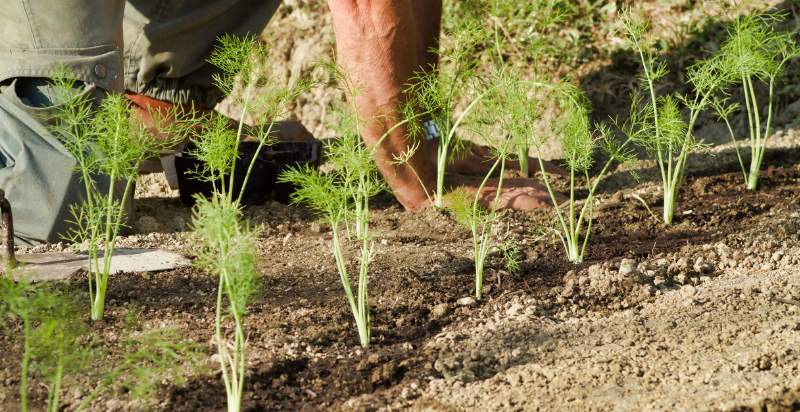
Additional Tips to Care for and Grow Fennel:
Fennel is an easy-to-grow, low-maintenance herb. It thrives in full sun or partial shade and requires well-drained soil. To keep the soil moist and reduce weed growth, apply a 2–3 inch layer of mulch around your fennel plants. To ensure healthy growth and prevent fungal diseases from developing on the leaves and stalks, thin out the plant as it grows by cutting off any excess stems at ground level.
To encourage strong growth, fertilize your fennel every two weeks with a liquid fertilizer or compost tea. When harvesting your fennel, cut off leaves at their base for fresh use or store them in a plastic bag in the refrigerator for up to 5 days.
The bulb can be harvested any time after it has reached full size (usually 6–8 weeks). Cut off the stalk just above the root ball and store it in a cool, dry place for up to 2 weeks. To harvest fennel seeds, wait until they turn brown before harvesting them in late summer or early fall.
You can enjoy a bountiful harvest of fresh fennel with proper care and attention. So get out there and start planting your delicious crop today.
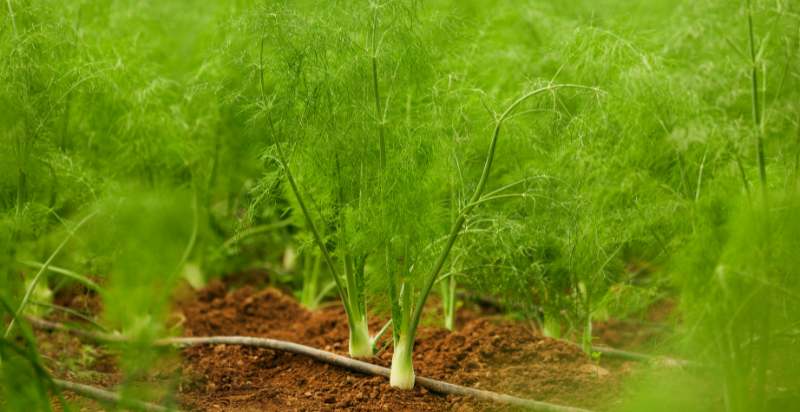
Preventions from Pests and Diseases:
Practice good garden maintenance to prevent pests and diseases from affecting your fennel crop. Remove any dead or damaged leaves and stems to reduce the chance of fungal infections. Keep an eye out for aphids, which can be eliminated with a strong blast of water or an insecticidal soap solution if needed.
Crop rotation is also recommended to minimize disease pressure in the soil. Fennel is susceptible to root rot, so you mustn’t over-water your plants or let them sit in wet soil for extended periods. Additionally, avoid overhead watering, as this can cause fungal leaf spots on the foliage. With proper care and prevention measures, you should have no trouble growing healthy fennel plants in your garden.
How to Harvest Fennel?
Fennel will be ready to harvest when the stalks and bulb are both plump and firm. To harvest the leaves:
- Cut them off at their base and use them immediately or store them in a plastic bag in the refrigerator for up to 5 days. The bulb can be harvested any time after it has reached full size (usually 6-8 weeks).
- Cut off the stalk just above the root ball, trim off any excess roots, and then store it in a cool, dry place for up to 2 weeks.
- If you’re growing fennel for its seeds, wait until they turn brown before harvesting them in late summer or early fall.
Following these steps, you should have no trouble learning how to harvest fennel and enjoying a bountiful crop! Your fennel plants should be fine with thriving with the right location, soil, and care.
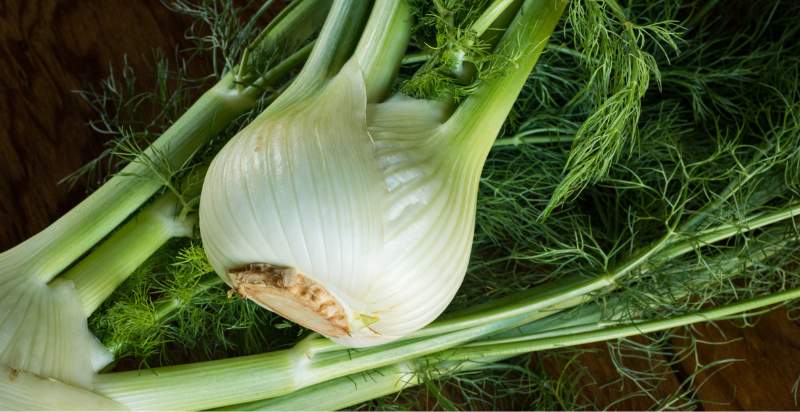
How to Store Homegrown Fennel?
Once harvested, fennel can be stored in the refrigerator for up to 2 weeks. The bulb should be wrapped loosely in a damp paper towel and placed inside a plastic bag to prevent it from drying. Leaves can also be stored in a plastic container or bag in the refrigerator for up to 5 days.
If you want to store your fennel for longer than two weeks, you can freeze it by blanching it first. To do this, cut off the stalks just above the root ball and place them into boiling water for 3-4 minutes, then transfer them into an ice bath immediately afterward. Once cooled, drain the fennel and wrap it tightly in freezer bags before storing it in your freezer.
Following these steps, you can learn how to store homegrown fennel and enjoy your harvest for months. Your fennel will remain fresh and delicious throughout the winter season with proper care and storage techniques.
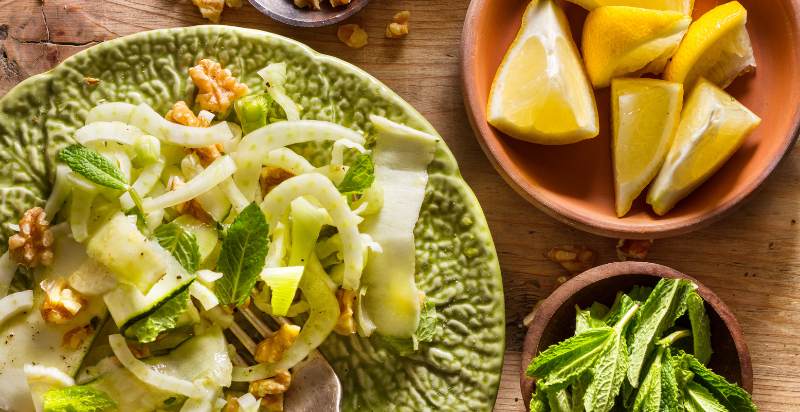
How to Use Fennel?
Fennel has many uses, both as a spice and in herbal medicine. Its most common culinary application is as an aromatic seed to flavor soups, stews, sauces, salads, and fish dishes. It can also be used to make tea or added to coffee grounds before brewing for a unique flavor. Fennel has long been included in herbal remedies, most often as a digestive aid. It is thought to be helpful for cramps, bloating, indigestion and gas. Fennel can also be used topically as an essential oil or tincture to soothe skin inflammation.
To use fennel medicinally, steep 1 teaspoon of crushed or ground fennel seed in boiling water for 10 minutes and strain. This tea can be sipped throughout the day or taken before meals to ease digestion. For topical application, mix a few drops of fennel essential oil into a carrier oil such as coconut oil and massage onto the affected skin area twice daily until symptoms subside. As with any herbal remedy, it’s best to consult your doctor before using fennel medicinally.
- Culinary use: Fennel can flavor soups, stews, sauces, salads, and fish dishes. It can also be used to make tea or added to coffee grounds before brewing for a unique flavor.
- Medicinal use: Fennel is thought to be helpful for cramps, bloating, indigestion and gas when taken as a tea or tincture. To make the medicinal tea, steep 1 teaspoon of crushed or ground fennel seed in boiling water for 10 minutes and strain. This tea can be sipped throughout the day or taken before meals to ease digestion.
For topical application, mix a few drops of fennel essential oil into a carrier oil such as coconut oil and massage onto the affected skin area twice daily until symptoms subside. As with any herbal remedy, it’s best to consult your doctor before using fennel medicinally.
Fennel is safe for most people when used as directed and may provide beneficial digestive support. Enjoy its unique flavor in the kitchen, or find relief from occasional indigestion with this common herb.
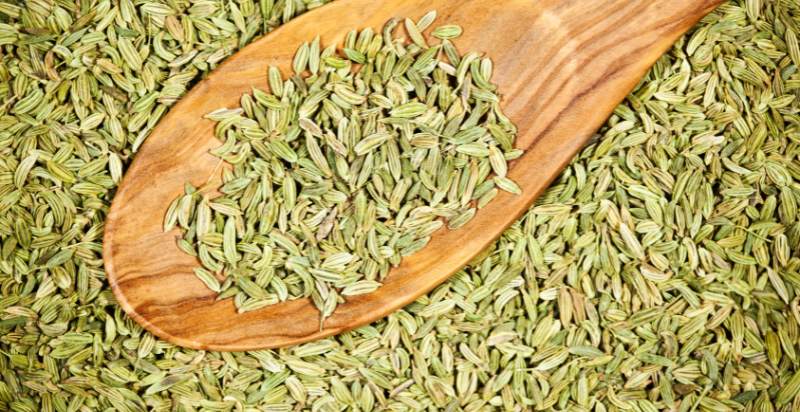
Potential Risks from Fennel:
Although fennel is generally safe for most people to consume, there are a few potential risks. People with known allergies to other members of the Apiaceae family, such as carrots, celery, and parsley, should avoid fennel due to the possibility of cross-reactivity. Additionally, fennel may interact with certain medications, such as blood thinners or those used for diabetes. It’s best to consult your doctor before adding large amounts of this herb into your diet.
Fennel can also be toxic when taken in large doses or on an empty stomach. Symptoms include nausea, vomiting, and diarrhea, so it’s best to follow dosage instructions carefully. Pregnant and breastfeeding women should avoid fennel supplementation due to a lack of safety data.
It’s also important to note that while there are many uses for fennel in herbal medicine, it is not meant to replace medical advice from a doctor or healthcare provider. If you’re experiencing digestive issues, please seek the guidance of a qualified healthcare professional.
Conclusion:
In conclusion, homegrown fennel can be enjoyed throughout the winter season as an aromatic spice or herbal remedy with proper storage and use. This herb is generally safe for most people when taken according to recommended doses and instructions. However, it is important to consult your doctor if you have any allergies or conditions that could be affected by its consumption. With these tips in hand, you can begin exploring fennel’s culinary and medicinal benefits. Happy eating .
- Everything You Wanted to Know About Red Tamarillos - June 2, 2025
- A Guide to Tulips: Everything You Need to Know & More… - June 2, 2025
- Guanabana: Description, Flavor, Benefits, And Uses - May 27, 2025

3 thoughts on “What is Fennel? How to Plant, Grow, and Harvest Fennel Bulb”
Comments are closed.